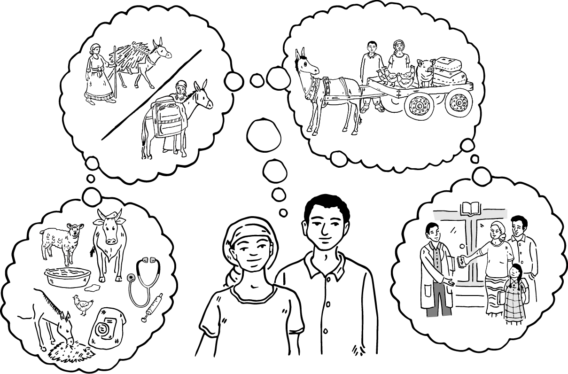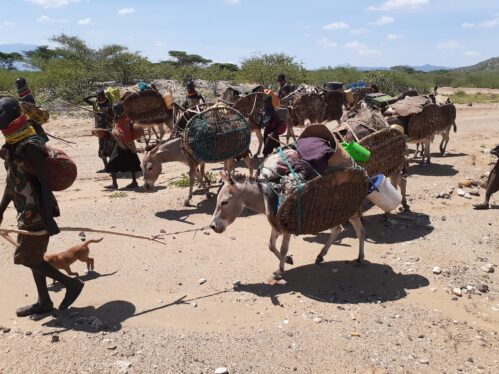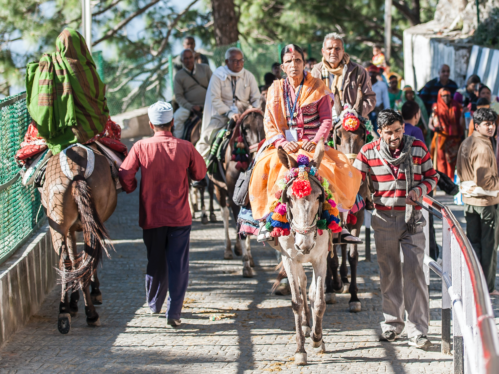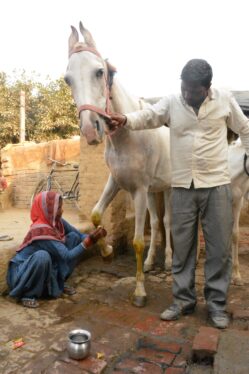QUICK LINKS
1.1 Understanding the important of animals of People
1.2 How Animal's Welfare Depends on People
1.3 Linking Human Behaviours to Positive Animal Welfare States
QUIZ 2: Relationships between Animals and People
Animals and humans have a long-intertwined histories. The “domestication and socialization of animals” is described as “an interactive process of cooperation and coevolution based on a shared need for shelter, food and protection [8]. This interdependent relationship is sometimes described as human-animal interaction or human-animal bond depending on the species of the animal and the key role/function they play in people’s lives e.g. supporting livelihoods, companion or service animal, farm animal, etc.
Just like humans, animals are sentient beings with feelings and welfare needs that need to be met. The nature of the interdependent relationship and associated human-animal bond shapes and determines how humans treat their animals and how animals experience their surroundings. Thus, animals’ welfare depends on their owners, carers, and users and the animal-human bond and interactions between them, and their compassionate handling, management, and use. The stronger the animal-human bond, the more animal owners or carers are likely to invest in positive animal welfare practices, for example when animals are considered family members [9].
Exploring the following key points can support people in understanding the importance of investing in their animals’ welfare and help increase their motivation to take action to improve it:
- The role animals play in people’s lives and associated benefits people experience because of their animals, and how adopting improved animal husbandry and management practices can create mutual benefits for both humans and animals.
- People’s beliefs and understanding about their animals’ as sentient beings, including their feelings and needs.
- Understanding animal welfare in terms of the five animal welfare domains.
- How people’s attitude and behaviours influences their animals’ welfare including their handling and husbandry practices.
The following sections focus on understanding animal welfare in terms of the nature of the human-animal relationship vis-à-vis the roles that humans and animals’ play in each other’s lives.
1.1 Understanding the Importance of Animals to People
People derive benefits from their animals depending on the role that animals play in their lives, whether it be by making peoples’ lives easier by relieving their physical labour burdens, supporting livelihoods, or through contributing to people’s emotional wellbeing as companions.
It is therefore our responsibility to ensure animals live a life worth living rather than just survive.
Understanding how individuals, households, and communities’ benefit from animals is important to effectively framing communications to help motivate people to take action to improve the welfare of their animals.
The following section outlines animals’ potential benefits to people in terms of livelihood assets and well-being which you may identify through discussion and observations with communities you work with.

Figure 15: (from left to right) Illustrating how ensuring working and production animals’ welfare helps support people in meeting their livelihood needs, including firewood collection, transport of goods for people and animals, and income generation helpful to paying school fees.
- Financial Capital: Animals may improve people’s opportunities for income generation, wealth accumulation, and related improvements in material living standards. Animals engage in many types of income generating activities which support people’s livelihoods and working animals may contribute to savings from hiring labour or transport. Animals may also be purchased as an investment, used to facilitate access to credit as a guarantee against a loan, and/or serve as a safety net for unexpected expenses.
- Social Capital: Animals contribute to strengthening social networks and building trust and reciprocity. For example, people may lend their animals to others in need (e.g. free transport services, helping plough fields, supporting ceremonial activities), which may later see a return of support to animals’ owners in their times of need. This mutual support can contribute to enhanced resilience through strengthened social networks, and enhanced trust and reciprocity. Working animals can help women or other disadvantaged groups to carry out social responsibilities, which may increase their level of respect and status within their community. Alternatively, animal ownership, care or use can be linked to social stigmas (e.g. low socio-economic status, uncleanliness). Such stigmas can negatively affect people’s attitudes and beliefs about themselves and their animals, which can further affect how they treat their animals. It is therefore important to understand the nature of people’s relationship with their animals and related attitudes and beliefs which may be motivating or hindering them from taking action to improve the welfare of their animals.
- Human Capital: animals support people’s health, attainment of skills and knowledge, and ability to work. For example, animals can act as transport providing access to healthcare services schools, and markets. They can also provide sources of nutrition’s either directly through meat and dairy products, or through farming inputs, which can promote good health. In this way, animals can support people’s attainment of knowledge and skills, as well as free up time and energy by reducing physical work burden which in turn may increase the availability of time and labour for investing in other pursuits.
- Physical Capital: working animals can be a vital transport asset for goods and people, as well as provide essential sources of draught power which support agricultural production and other industries value chains’ (construction, infrastructure), which can be critical to supporting people’s livelihoods.
- Natural Capital: animals themselves are natural resources natural resources from which further resources and services can be developed to support people’s livelihoods. Working animals can be also an important asset for enhancing access to natural resources such as fuel and firewood, food, feed, and water, as well through supporting agricultural inputs and outputs. Animal owners and users may also benefit from access to communal lands, water, and forest resources, or alternatively experience increased conflict over resources as a result their animal keeping.
- Reducing Vulnerability: working animals and livestock can be valuable assets which contribute to communities’ resilience to natural shocks and disasters. For example, donkeys help transport water long distances to drought affected areas, help families move when natural disasters strike, and support pastoralist communities during migration.

Figure 16: Donkey’s supporting migration of Pastoralist communities in Turkana
- Psychological, emotional, and spiritual well-being: animals can contribute for humans “well-being, connectedness, and resilience”, particularly in the case of domestic pets, companion animals, and service animals, by providing pleasure, relaxation, affection, loyalty, joy, and comfort [8]. In addition, animals can play a role in providing people with a sense of security through their contributions to income and food production, thereby reducing people’s exposure to unexpected shocks, and their ability to withstand shocks they may encounter. Leisure activities involving animals can also contribute to people’s sense of joy, freedom, and/or personal achievement (e.g. horseback riding, animal agility or show competitions).
- Cultural and Spiritual Significance: Animals have had important cultural and spiritual significance attached to them throughout human history and are often well treated when they hold significance in cultural and religious teachings or practices [8]. Perceived cultural benefits may be derived when animals are used during cultural ceremonies like celebrations, memorials, and/or important sporting events. People may also derive cultural benefits if there is a significant cultural or group identity attached to being an animal owning community, for example cattle pastoralists’ sense of identity can be strongly linked with their keeping of animals or size of herd. In addition, understanding how animal species are depicted and characterized within cultural stories, literature, and within day-to-day sayings, as well people’s cultural values and beliefs about their animals and their identity, can provide useful insights into what drives people’s behaviours, and how to effectively communicate to motivate the adoption of improved animal welfare practices.

Figure 17: Horses supporting cultural and social activities in Ethiopia.

Horses supporting cultural and social activities in India.

Case Study
Improving Animal Welfare Benefits People
In the Helwan region near Cairo, a huge collection of brick kilns produces 200 million red bricks every month in 2010, relying on over 1500 donkeys and 324 mules to pull brick carts.
Brick kiln donkeys have many welfare problems, including dehydration, poor body condition, foot problems and wounds from saddles and from beating. Due to the harsh conditions in which they live and work, their mortality rate is high, and many donkeys die young.
The Brooke Hospital for Animals supported an equine welfare improvement project to address equid welfare issues in Brik Kilns and facilitated meetings and trainings with brick kiln and animal owners to build their capacity to provide for their working animals’ welfare. Monitoring results indicated the age of working animals in brick kilns was increasing over the course of the project. Factory owners recognized that the turnover of working animals had sharply decreased, and that workers’ animals seemed to be living longer and able to be more productive and generate more income. A factory owner cited this being the result of improved donkey feeding practices during the peak working season. Another brick kiln worker and owner of several donkeys explained that water was a problem in the peak season and causing his donkeys to suffer. His solution to this issue was moving the water source inside the stable to give the animals more opportunities to drink. He noted that his animals’ health seemed to improve and that they felt so happy.
Over the years these very small adjustments have made a real difference to the welfare of the donkeys, reducing mortality rates, and prolonging their lives at the brick kilns.
Source: Mohamed Hammad, Ahmed El Sharkawy and Amro Hassan, Brooke Egypt, January 2010
There are many ways in which animals create value in our lives; however, animals’ provision of benefits to people, or lack thereof, is not the sole justification for people to address animal welfare issues. Rather understanding these benefits when they exist, along with people’s attitudes and beliefs about their animals and their treatment, can inform how best to engage people to motivate them to improve their animals’ welfare. Animals’ intrinsic value as sentient beings is sufficient reason for people to promote positive animal welfare states; however, may still require changes in social norms and values to support increased compassion for animals.
1.2 How Animal's Welfare Depends on People
The welfare of animals varies depending on a complex range of factors influencing their lives, many of which are dependent or determined by humans. Unlike wild animals, domesticated animals depend on humans for their welfare, and may not have the freedom to express their natural behaviour and depend on people to meet their needs. Working and production animals often have a very restricted and unnatural life, deprived of their freedom of movement and ability to express natural behaviours. Regardless of animal species, people who choose to keep animals are ultimately responsible for their animals’ life experiences, as these animals are dependent on people for meeting their needs.
The figure below illustrates the variety of determinants influencing animal welfare. The central, middle circle represents the animal factors which influence animal welfare, whereas the second, third and fourth layers are examples of the determinants of welfare which are dependent on humans, highlighting how much a domesticated animal’s welfare depends on people and is beyond the control of the animal them self. In the second layer, you can see direct influences on animals’ welfare related to their immediate living and/or working conditions, such as housing, nutrition, workload, handling, disease prevention and treatment, all of which are dictated by people. This could be considered in line with the five domains of welfare discussed in previous sections.

Figure 18: Determinants of Animals' Welfare (Adapted from [10])
The third layer shows the factors which influence the animal’s living and working conditions and therefore determines their welfare indirectly. These are similarly human determinants and may include the knowledge and capacity of the people who interact with the animal, the services available (including animal health services), the resources available in the locality and, among those, the specific resources that owners choose to provide, depending on what they can afford. This layer also contains the belief systems and traditions of the people dealing with the animal, the influence of their peers and social network, their social status, and their income level.
The outer layer represents more general socio-economic and environmental factors which influence the third layer. These may include social structures, income opportunities or wages, droughts and floods, mobility patterns, urbanisation, fuel prices and changes in policies. Together the third and fourth level can be considered determinants of human behaviour related to people’s capability, opportunity, and motivation for ensuring their animals’ animal welfare. Within this diagram, the human factors, or determinants of animal welfare influence each other within each layer and between one layer and the next. To be successful in sustainably improving welfare, several determinants will likely need to be addressed at the same time amongst the people regularly interacting with the animal and the systems in which animals and people live and/or work. Some factors influencing animal welfare are within the owner’s control, such as whether they are beaten, or what time of day they are fed. However, many factors cannot be influenced by individual animal owners because they are part of a wider living and working system, or socio-economic system. Thus, for people to be able to meet the needs of their animals and improve their welfare, a holistic and systems-based approach is recommended to understand and address the variety of factors influencing the behaviours of animal owning communities.
It is also important to note that animals’ welfare needs are not static. Just as the human circumstance affects peoples’ needs and related ability to meet them, animals’ needs and feelings may similarly change with the changing circumstances of their owners, and in response to changing circumstances they experience over the course of each day, season, or lifetime. The points below highlight general circumstances in which an animal’s needs may change, and which may require the people they depend on to adapt their husbandry and management practices to enable them to continue to thrive and experience positive welfare states.
- Changes in the local context/environment: Animals’ welfare needs change depending on the circumstances and context as well. Sometimes when the community environmental context or circumstances change (e.g. in times of crisis or emergency), animals’ roles can change which can further result in changes in animals’ needs and related welfare (e.g. equids during humanitarian crisis, or search and rescue dogs). Changes in animals’ roles can require changes in care and management practices to meet the resultant changing needs of animals.
- Animals’ welfare needs change depending on their age during their lifetime: Just like people, animals experience mental and physical changes and challenges during their lifetime. The needs and feelings of animals are likely to change as they reach middle and older age. There are many reasons for this, such as changes in nutritional needs, working ability and the amount of rest or care needed by the animal and provided by their owner.
- Animals’ welfare needs change when seasons change: Within a single year, people and their working animals will experience many changes and challenges according to the climate, workload, food availability, income and other livelihood and environmental factors. In different countries and regions there will be different seasons or times of change within a livelihood system in one year and these will affect the welfare of animals.
- Animals’ welfare needs change during a single day: Within a single day, working animals will experience changes and challenges to their welfare. These will be influenced by their living, working and resting conditions and their health status. They will also depend on the opportunities to experience positive feelings that are provided by their environment and the people and other animals around them.

As circumstances affecting animals’ needs change, people’s animal husbandry and management practices may need to adjust to provide for their animals’ welfare and ensure their animals continue to experience positive welfare states to the extent feasible.
The five domains framework is helpful for understanding how animals’ positive life experiences can be improved even within the contextual constraints people may face which are out of their control, since it doesn’t seek to ensure the animal is free from all issues which may not be possible.
Small changes can make a big difference to an animal’s overall welfare, with each little bit is contributing to the mental state and small gains in the animals’ overall welfare.
Look after your animals and
they will look after you.
Figure 19: Woman in India checking and cleaning her working horse’s hooves to promote hoof health and prevent lameness.
1.3 Linking Human Behaviours to Positive Animal Welfare States
People have control over the lives of animals, and determine when their animals eat, drink, sleep, what they can do, where they can go, and what other animals they can meet. People are responsible for their animals’ well-being because they choose to keep animals and derive benefits from them. It is therefore important to understand who is responsible for the animals’ welfare state, and what behaviour should be targeted to improve it, as well as whether they have adequate knowledge and skills and access to sufficient resources and services to change. However, it is also essential to see things from the animal’s point of view, so not only are we asking, ‘Is the owner providing inputs or resources,’ but also: ‘Is the animal really getting what they need?’
Think about the animals in the communities where you will work, and how they spend their day. What activities comprise their day, how much time are they being active or resting? Describe who the animals depend upon to stay in a good, healthy state? Who feeds them and gives them water? Who cleans the area where they are kept? What care do people who own the animals believe they need, and who is responsible for providing that care?
It is not usually practical or realistic to give an animal absolutely everything they need to keep them feeling good all the time, every day, every season, throughout their life. However, the more animal needs that can be met, and the better their feelings are understood, the better their welfare can be. Incremental improvements in management practices and access to resources and service and decreases in poor husbandry and management practices and use of poor-quality resources and services can make a difference to animal welfare. Some changes will make an immediate, short-term difference, while others will make a sustainable, long-term difference. All of them are valuable and small steps are better than no action at all.
As animals are fully contributing members of our communities that are sentient and can feel pain, fear, and stress as well as a wide range of positive emotions, an animal can have both good and bad experiences throughout their life. Animal owning communities can therefore proactively promote good overall welfare by preventing negative experiences and promoting positive experiences. Considering and providing for the animal’s needs and feelings as much as possible, using the five domains for reference, is also important to preventing welfare problems from developing. Preventing welfare problems before they happen tends to be easier than successfully treating them when they arise and is in the best interest of animals and communities who own them. “Without good care, animals can become sick, weak, unhappy, and unproductive. For example, a working animal in a poor welfare state cannot thrive and provide a family with income in the way that a fit and healthy animal does. In contrast, if welfare problems are prevented and the needs of animals are met, animals are more likely to be in good physical condition and have fewer episodes of disease or injury and are more likely to experience greater positive emotions and less negative emotional experiences.
While understanding what animals need is a useful first step when working with animal owning communities, this understanding needs to be linked to what communities can do to meet those needs to promote behavioural change for animal welfare improvement. To do this, you can use the five domains framework to craft a similar framework linking the human behaviours communities can undertake to promote positive welfare states. A general non-species-specific example is provided in the figure below.

Figure 20: Examples of human behaviour supporting the five domains
Mapping human behaviours within the five domains is recommended when working with communities as it helps to reframe the welfare issues into actionable human behaviours that promote positive welfare states and supports animal owners to identify alternative actions for improving their animals’ quality of life, even when external constraints may impede their ability to address some welfare issues (e.g. insufficient financial resources of access to animal related services).